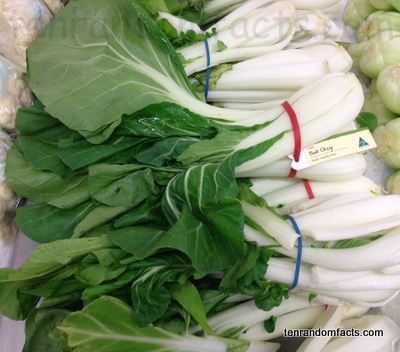You can’t get a vegetable with a name much stranger than bok choy.
- Bok choy is a leafy vegetable, dubbed as an ‘Asian green’, that generally has large leaves that clusters upwards from its base.
- The scientific name of bok choy is Brassica rapa chinensis, previously known as Brassica chinensis, and it is from the family Brassicaceae, the family of cabbages and mustards.
- ‘Bok choy’ is also known as ‘bok choi’, ‘buk choy’ ‘white cabbage’, ‘Chinese chard’, ‘Chinese cabbage’, ‘Chinese savoy’, ‘Chinese white cabbage’, ‘white Chinese cabbage’, ‘Chinese mustard’, ‘Chinese mustard cabbage’, ‘spoon cabbage’, ‘pak choy’ and ‘pak choi’.
- The translation of the Cantonese words ‘bok choy’ is ‘white vegetable’ in English, and there is often great confusion over the vegetable’s numerous names, which can vary depending on country or location, while some refer to different varieties.
- The leaves of bok choy are a green colour, and the stalks are coloured white to green, depending on the variety or type, while the term ‘pak choy’ will often refer to the green stemmed variety.
- Bok choy originated in China, in Asia, and have been grown there since 400 AD, and it wasn’t until the late 1700s that they were introduced to Europe.
- Both the stems and leaves of bok choy are eaten, and they are often cooked through stir-frying, while other methods include steaming, boiling and microwaving.
- To decrease the likelihood of leaves wilting, harvesting of bok choy is performed during cooler hours, such as morning, and they are best stored in the refrigerator.
- The thick stalks of bok choy are firm and crunchy, while the leaves are relatively thin and pliable.
- In addition to many other beneficial vitamins and minerals, bok choy is very high in vitamin A, C and K, and it is particularly useful in decreasing the likelihood of inflammation and cancer.
Bibliography:
Bok Choy, 2011, Fresh For Kids, http://www.freshforkids.com.au/veg_pages/bok_choy/bok_choy.html
Bok Choy, 2015, Wikipedia, https://en.wikipedia.org/wiki/Bok_choy
Bok Choy, 2015, The World’s Healthiest Foods, http://www.whfoods.com/genpage.php/genpage.php?tname=foodspice&dbid=152







